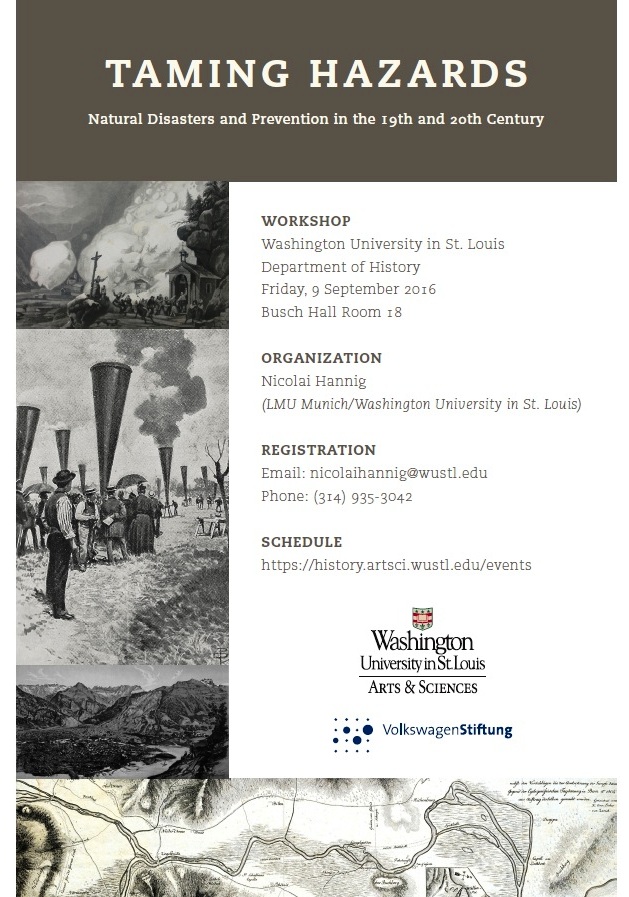Projekt Taming Hazards
Natural Disasters and Prevention in the 19th and 20th Century
International Workshop, Washington University in St. Louis/USA
Friday, 9 September 2016, Busch Hall Room 18

Program
Nicolai Hannig
Taming Hazards. Natural Disasters and Prevention in Germany and Switzerland in the 19th Century
Gillen D'Arcy Wood
“Migrate? Adapt? Other?” A Comparative Historical Study of Community Response to Abrupt Global Climate Deterioration and its Consequences, 1816-18
Diana DiStefano
How Local Knowledge Influenced Liability Law in Avalanche Country and Beyond, 1880-1920
Jeffrey H. Jackson
Historical Forgetting, Historical Memory, and Disaster Prevention
Scott Gabriel Knowles
Slow Disaster: The Importance of Scale in Disaster Research and Policy
James R. Fleming
Climate Engineering: Barking Mad, WEIRD, and Male-Dominated Disasters
Abstract
At all times societal development has been preconditioned by man’s protection from and mastery or overcoming of natural hazards. Yet precaution and prevention are far more recent stances, which both gained importance at the turn of the 19th century. Similar to the creation of security, both of these concepts are variations of one and the same approach towards the future, which was now not merely accepted passively, but increasingly shaped actively. From an analytic point of view prevention can be seen as a form of coping with contingency, and as a restriction of the risk of experiencing unwanted natural hazards. Premodern societies interpreted natural incidents mainly religiously and according to their everyday experiences. During the 19th and 20th century this type of interpretation did not disappear, but was rather supplemented by more and more secular, science and engineering oriented response strategies. The development of modern forms of prevention became professional, and at the same time the expectations towards state regulatory measures and guarantees grew. Therefore, the relationship between man and nature realigned – which can be one of the workshop’s basic assumptions. With the formation of the welfare state individuals’ claims became more demanding, and their cries for protection from natural hazards louder and louder. Gradually, people became convinced that unpleasant natural incidents could be ‘prevented’, ‘calculated’, and ‘insured’.
A first proposition could be that humans provided less and less for their protection from nature themselves. Increasingly, they made supra-individual and collective agents responsible for this task, such as public authorities, civil society organizations or scientific bodies. In turn, modern states not only protected their citizens from dangers: they took these hazards into account, often perceived them even as a possibility, cause, or obligation for governance. Diverse forms of ‘managing fear’ arose, in new technical safeguards, protection commissions, insurance products as well as cultural strategies. Soon there was a differentiation in dealing with natural hazards: in their risk management, politics and sciences began distinguishing between actual and potential dangers. The aim was not only to process the damaging events that were known, experienced and faced, but also those that were merely possible, too. So disaster developed into a scenario which had to be prevented or, at least, whose effects should be curbed.
The aim of our workshop is to remove the term ‘prevention’ from the field of law and medicine and try to crystalize its analytic potential with the example of disaster prevention. Prevention is the anticipation of the future, a line of thought and action to optimize the present by organizing the future. But which authorities developed preventive ideas? How were they accomplished in practice? Our goal is to examine the instable balance between nature’s forces and humans’ intervention into these powers. Methodically, the papers could bundle approaches of environmental history and history of science, and question in how far man and environment relations have moved towards contexts of preventive ideas since the beginning of the 19th century. Thus, our workshop will link the analyses to exemplary regional, national and global contexts from Europe to the United States. Therefore, dealing with natural hazards could be analyzed in the conflict between nation-building and international interrelations because protection from nature has always been perceived from a national and yet global view, as well.
Organization
Dr. Nicolai Hannig
Department of History
Washington University in St. Louis
Campus Box 1062
1 Brookings Drive
St. Louis MO 63105, USA
Registration
Nicolai.Hannig@wustl.edu
Phone: 314-935-3042
Downloads
- Taming_Hazards_Brochure (2 MByte)
- Taming Hazards_Poster (3 MByte)

